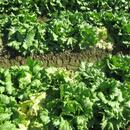All
What is Salmonellosis?
- The most common foodborne illness
- A one-celled organism (usually Typhimurium and Enteritidis) known as salmonella
- Common to the intestinal tracts of many warm-blooded animals, including cows and chickens; sometimes found in the feces of animals and infected humans
- Salmonella Newport was discovered by the National Antibiotic Resistance Monitoring System (NARMS), an interactive agency cooperative consisting of the CDC, FDA, and USDA
Typical Symptoms
- Fever
- Abdominal cramps
- Diarrhea
- Rarely, death
Most at risk
- Young children
- Elderly
- Immunocompromised
How is it Spread?
- Through food contaminated with animal feces
- Through direct or indirect contact with infected individuals
- Examples
- Presence of the bacterium in the water supply
- If an infected person does not wash his/her hands properly after using the toilet, bacteria may be passed by physical contact or by handling food
- Cross-contamination: utensils used on uncooked foods such as meats or eggs could spread the bacteria if then used on produce to be eaten raw

Caused by a type of soil-borne fungus, Sclerotinia prefers moist, humid conditions. The disease mainly affects mature lettuces, as well as other leafy greens, beans, cucumbers, citrus, melons, potatoes, and tomatoes. Symptoms include water-soaked spots on leaves that can become slimy or dry lesions on the stalk, stems, and branches that turn yellow, then brown.
Shatter is a term used to explain what happens when individual grapes become disconnected from the vine, usually through rough handling during harvesting, packaging, transportation, or receiving.
What is Shigellosis?
Any of the four main species of the pathogen Shigella. Most cases occur in regions with sub-standard hygiene and unsafe water supplies. A few cases of Shigellosis are reported in the US each year.
Typical Symptoms
- Fever
- Severe abdominal cramps
- Diarrhea
- In the most serious cases, seizures and death
Most at risk
- Young children
- Elderly
- Immunocompromised
How is it Spread?
- By contaminated food or water
- Person-to-person contact
-
Harbored in human feces only
- Examples
- If an infected person does not wash his/her hands properly after using the toilet, they may pass along the bacteria by physical contact or by handling food
- If contaminated water touches food at any stage (irrigation, washing, rinsing, etc.), food may also become contaminated
Specifications are detailed descriptions of requirements, such as dimensions, materials, defect allowances, etc. In the produce industry, specifications define minimum acceptable levels of quality and, as such, play a key role in product consistency.
Every item packed under the Markon First Crop, Ready-Set-Serve, and Markon Essentials brands must meet or surpass standards written by Markon. Our supplier partners know that if their crops cannot meet the written standards, for whatever reason, they can not pack the brand.
Limes can be affected by stylar end rot when left on the tree too long or in poor weather conditions. It occurs at the end of the individual fruit, usually while on the tree, although much of yellow or brown rot occurs while in storage. The stylar end of the fruit becomes cracked, discolored, and decayed.
